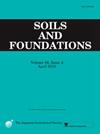Experiments for the role of sliding connection in rigid faced GRS walls under transverse relative settlement
IF 3.3
2区 工程技术
Q2 ENGINEERING, GEOLOGICAL
引用次数: 0
Abstract
The transverse relative settlement of reinforced fill and fascia induces reinforcement loads additional to service loads in Geosynthetic Reinforced Soil (GRS) Walls. The fascia-reinforcement connections need due attention in such conditions for both strength and serviceability considerations. A sliding connection is an alternative to avoid the buildup of high reinforcement connection loads under the relative settlement. 1-g model tests were carried out in an in-house developed relative settlement simulator tank on full-height panel rigid fascia (RF) GRS walls with two types of conventional connection systems. The sliding connection system was developed and proposed for RF-GRS walls, and its performance was assessed under the relative settlement of fill. In RF-GRS walls with conventional connection systems, the maximum tensile strains increased more than 200 times in bottom reinforcement layers under the relative settlement of 0 to 200 mm compared to the end of the construction. The developed sliding connection systems reduced the stress concentrations at the connection and allowed almost free settlement of the fill relative to the fascia. The maximum reinforcement strains were reduced up to 50 times compared to conventional non-sliding connections under the relative settlement of 0 to 200 mm. Hence, the sliding connection systems are recommended in conditions where the relative settlement of fascia and fill is expected to affect RF-GRS walls’ performance.
横向相对沉降作用下刚性面GRS墙体滑动连接作用试验
在土工合成加筋土(GRS)墙体中,加筋土填土和筋膜的横向相对沉降会产生除使用荷载外的加筋荷载。在这种情况下,筋膜加固连接需要对强度和适用性进行适当的考虑。滑动连接是避免在相对沉降下高配筋连接荷载积累的一种替代方法。在自行研制的相对沉降模拟槽中,对采用两种常规连接系统的全高面板刚性筋膜(RF) GRS墙体进行了1g模型试验。提出了一种适用于RF-GRS墙体的滑动连接系统,并对其在填料相对沉降下的性能进行了评价。在采用常规连接体系的RF-GRS墙体中,在相对沉降为0 ~ 200 mm的情况下,底层配筋层的最大拉伸应变较施工结束时增加了200倍以上。开发的滑动连接系统减少了连接处的应力集中,并允许填充物相对于筋膜几乎自由沉降。在相对沉降0 ~ 200mm的情况下,与传统的非滑动连接相比,最大钢筋应变降低了50倍。因此,在筋膜和填充物的相对沉降影响RF-GRS墙体性能的情况下,推荐采用滑动连接系统。
本文章由计算机程序翻译,如有差异,请以英文原文为准。
求助全文
约1分钟内获得全文
求助全文
来源期刊

Soils and Foundations
工程技术-地球科学综合
CiteScore
6.40
自引率
8.10%
发文量
99
审稿时长
5 months
期刊介绍:
Soils and Foundations is one of the leading journals in the field of soil mechanics and geotechnical engineering. It is the official journal of the Japanese Geotechnical Society (JGS)., The journal publishes a variety of original research paper, technical reports, technical notes, as well as the state-of-the-art reports upon invitation by the Editor, in the fields of soil and rock mechanics, geotechnical engineering, and environmental geotechnics. Since the publication of Volume 1, No.1 issue in June 1960, Soils and Foundations will celebrate the 60th anniversary in the year of 2020.
Soils and Foundations welcomes theoretical as well as practical work associated with the aforementioned field(s). Case studies that describe the original and interdisciplinary work applicable to geotechnical engineering are particularly encouraged. Discussions to each of the published articles are also welcomed in order to provide an avenue in which opinions of peers may be fed back or exchanged. In providing latest expertise on a specific topic, one issue out of six per year on average was allocated to include selected papers from the International Symposia which were held in Japan as well as overseas.
 求助内容:
求助内容: 应助结果提醒方式:
应助结果提醒方式:


